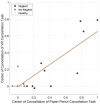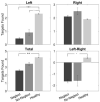Immersive 3D Virtual Reality Cancellation Task for Visual Neglect Assessment: A Pilot Study
- PMID: 32528265
- PMCID: PMC7263018
- DOI: 10.3389/fnhum.2020.00180
Immersive 3D Virtual Reality Cancellation Task for Visual Neglect Assessment: A Pilot Study
Abstract
Background: Unilateral spatial neglectis an attention disorder frequently occurring after a right-hemispheric stroke. Neglect results in a reduction in qualityof life and performance in activities of daily living. With current technical improvements in virtual reality (VR) technology, trainingwith stereoscopic head-mounted displays (HMD) has become a promising new approach for the assessment and the rehabilitation of neglect. The focus of this pilot study was to develop and evaluate a simple visual search task in VR for HMD. The VR system was tested regarding feasibility, acceptance, and potential adverse effects in healthy controls and right-hemispheric stroke patients with and without neglect. Methods: The VR system consisted of two main components, a head-mounted display to present the virtual environment, and a hand-held controller for the interaction with the latter. The task followed the rationale of diagnostic paper-pencil cancellation tasks; i.e., the participants were asked to search targets among distractors. However, instead of a two-dimensional setup, the targets and distractors were arranged in three dimensions, in a sphere around the subject inside its field of view. Usability and acceptance of the task, as well as the performance in the latter, were tested in 15 right-hemispheric subacute stroke patients (10 of whom with and five of whom without unilateral spatial neglect; mean age: 67.1 ± 10.5 years) and 35 age-matched healthy controls. Results: System usability and acceptance were rated as high both in stroke patients and healthy controls, close to the maximum score of the questionnaire scale. No relevant adverse effects occurred. There was a high correlation (r = 0.854, p = 0.002) between the Center of Cancellation [an objective neglect measure) calculated from a paper-pencil cancellation task (Sensitive Neglect Test (SNT)] and the newly developed VR cancellation task. Conclusion: Overall, the developed visual search task in the tested VR system is feasible, well-accepted, enjoyable, and does not evoke any significant negative effects, both for healthy controls and for stroke patients. Findings for task performance show that the ability of the VR cancellation to detect neglect in stroke patients is similar to paper-pencil cancellation tasks.
Keywords: cancellation task; head-mounted display; immersive virtual reality; stroke; visual neglect.
Copyright © 2020 Knobel, Kaufmann, Gerber, Cazzoli, Müri, Nyffeler and Nef.
Figures







Similar articles
-
Effects of Virtual Reality-Based Multimodal Audio-Tactile Cueing in Patients With Spatial Attention Deficits: Pilot Usability Study.JMIR Serious Games. 2022 May 25;10(2):e34884. doi: 10.2196/34884. JMIR Serious Games. 2022. PMID: 35612894 Free PMC article.
-
Immersive virtual reality during gait rehabilitation increases walking speed and motivation: a usability evaluation with healthy participants and patients with multiple sclerosis and stroke.J Neuroeng Rehabil. 2021 Apr 22;18(1):68. doi: 10.1186/s12984-021-00848-w. J Neuroeng Rehabil. 2021. PMID: 33888148 Free PMC article. Clinical Trial.
-
Validation of an immersive virtual reality system for training near and far space neglect in individuals with stroke: a pilot study.Top Stroke Rehabil. 2017 Oct;24(7):533-538. doi: 10.1080/10749357.2017.1351069. Epub 2017 Jul 12. Top Stroke Rehabil. 2017. PMID: 28701101
-
Virtual Reality and Eye-Tracking Assessment, and Treatment of Unilateral Spatial Neglect: Systematic Review and Future Prospects.Front Psychol. 2022 Mar 22;13:787382. doi: 10.3389/fpsyg.2022.787382. eCollection 2022. Front Psychol. 2022. PMID: 35391965 Free PMC article.
-
Head-Mounted Display-Based Therapies for Adults Post-Stroke: A Systematic Review and Meta-Analysis.Sensors (Basel). 2021 Feb 5;21(4):1111. doi: 10.3390/s21041111. Sensors (Basel). 2021. PMID: 33562657 Free PMC article.
Cited by
-
Virtual reality for the assessment and rehabilitation of neglect: where are we now? A 6-year review update.Virtual Real. 2022;26(4):1663-1704. doi: 10.1007/s10055-022-00648-0. Epub 2022 May 30. Virtual Real. 2022. PMID: 35669614 Free PMC article.
-
Virtual reality gameplay classification illustrates the multidimensionality of visuospatial neglect.Brain Commun. 2024 May 3;6(4):fcae145. doi: 10.1093/braincomms/fcae145. eCollection 2024. Brain Commun. 2024. PMID: 39165478 Free PMC article.
-
Development of a Search Task Using Immersive Virtual Reality: Proof-of-Concept Study.JMIR Serious Games. 2021 Jul 2;9(3):e29182. doi: 10.2196/29182. JMIR Serious Games. 2021. PMID: 34255653 Free PMC article.
-
Rapid assessment of hand reaching using virtual reality and application in cerebellar stroke.PLoS One. 2022 Sep 29;17(9):e0275220. doi: 10.1371/journal.pone.0275220. eCollection 2022. PLoS One. 2022. PMID: 36174027 Free PMC article.
-
Extended reality to assess post-stroke manual dexterity: contrasts between the classic box and block test, immersive virtual reality with controllers, with hand-tracking, and mixed-reality tests.J Neuroeng Rehabil. 2024 Mar 15;21(1):36. doi: 10.1186/s12984-024-01332-x. J Neuroeng Rehabil. 2024. PMID: 38491540 Free PMC article. Clinical Trial.
References
-
- Azouvi P., Bartolomeo P., Beis J.-M., Perennou D., Pradat-Diehl P., Rousseaux M. (2006). A battery of tests for the quantitative assessment of unilateral neglect. Restor. Neurol. Neurosci. 24, 273–285. - PubMed
-
- Azouvi P., Marchal F., Samuel C., Morin L., Renard C., Louis-Dreyfus A., et al. (1996). Functional consequences and awareness of unilateral neglect: study of an evaluation scale. Neuropsychol. Rehabil. 6, 133–150. 10.1080/713755501 - DOI
LinkOut - more resources
Full Text Sources
Other Literature Sources

